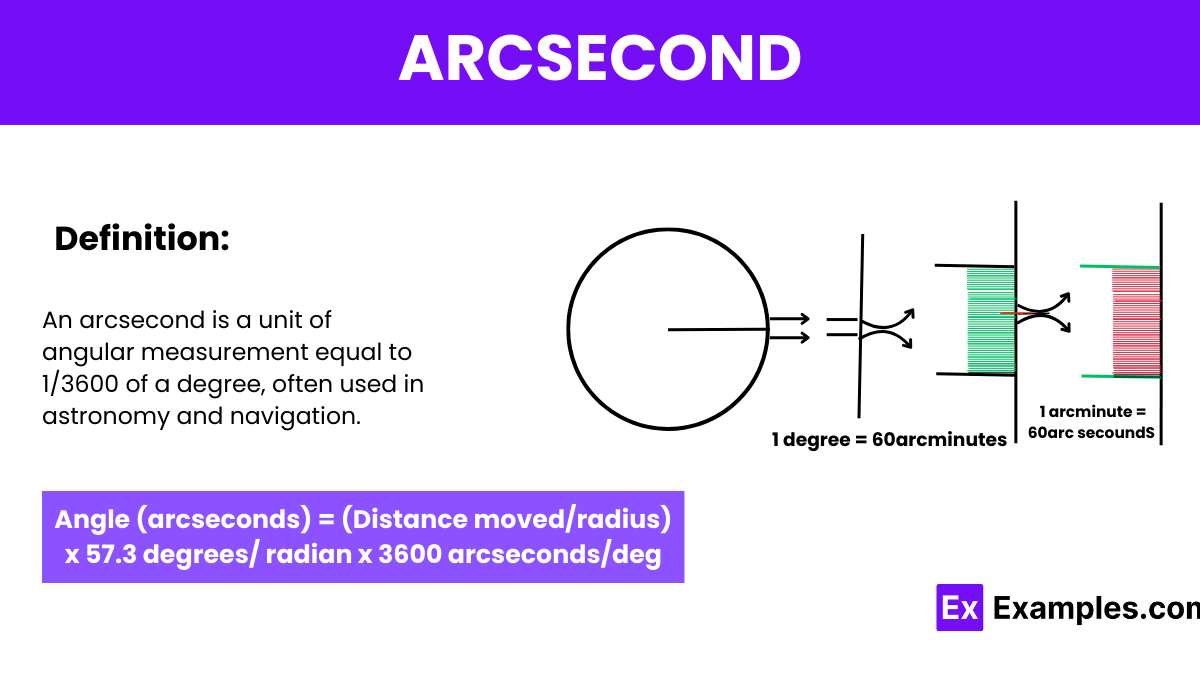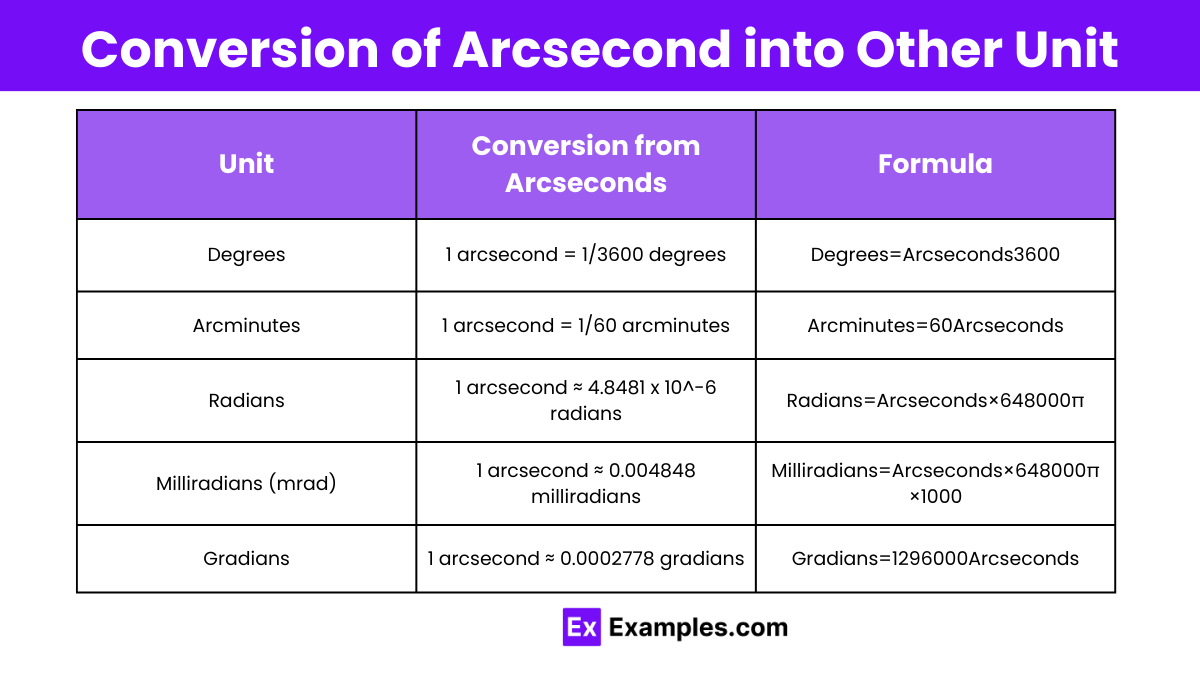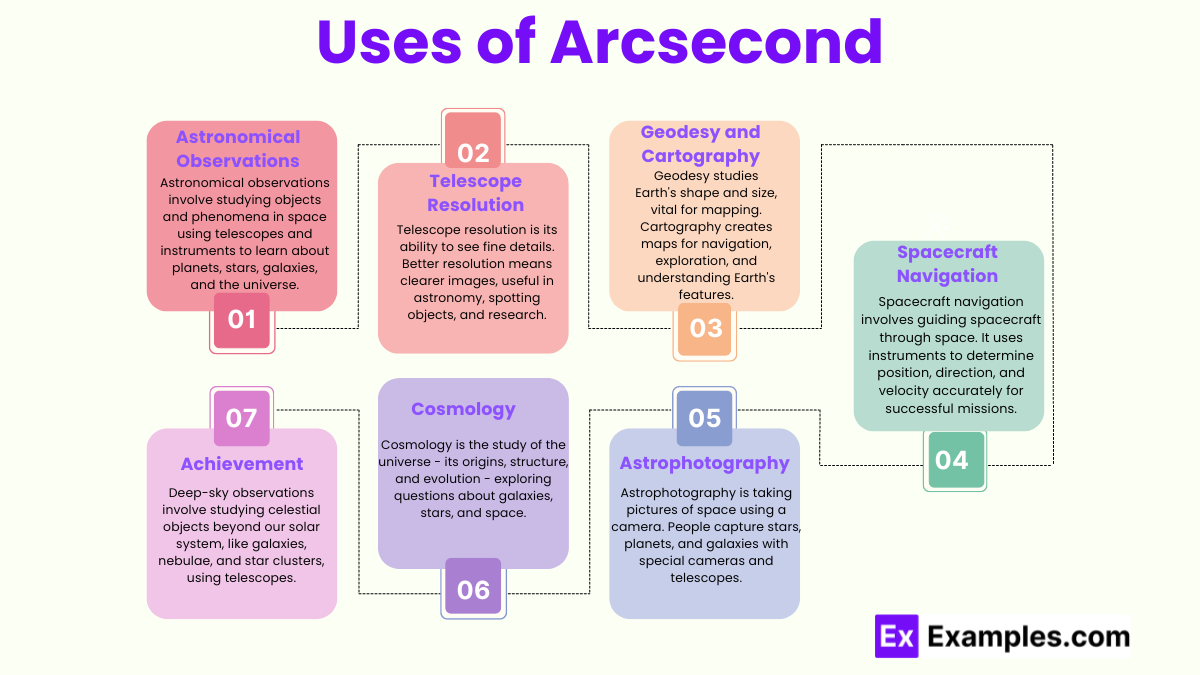What is an arcsecond used to measure?
Temperature
Time
Angular distance
Speed


Arcsecond is a unit of angular measurement used in astronomy, which is equivalent to 1360036001 of a degree. Since a degree is divided into 60 arcminutes and each arcminute is further divided into 60 arcseconds, there are 3600 arcseconds in a single degree.
Angular Distance between Two Points on the Celestial Sphere
For two points on the celestial sphere, given by their right ascension (RA) and declination (Dec), the angular distance Δθ can be approximated using:
where:
Dec₁ and Dec₂ are the declinations,
ΔRA is the difference in right ascension between the two points, expressed in degrees (convert from arcseconds or arcminutes as necessary).
Parallax
The parallax of an object, particularly of a star, can give its distance from Earth. If a star’s parallax is measured in arcseconds, the distance d in parsecs can be calculated using
where p is the parallax in arcseconds. This is a fundamental concept in stellar distance measurements.
Resolving Power of a Telescope
The minimum angular separation θ that a telescope can resolve is determined by the Rayleigh criterion
where:
λ is the wavelength of light,
D is the diameter of the telescope’s aperture,
θ is given in radians (can be converted to arcseconds:
θ(arcseconds)=θ(radians)×206265).
Proper Motion
The proper motion of a star measured in arcseconds per year is crucial for understanding its motion through space relative to the solar system. It can be calculated from observed changes in position over time, providing insights into stellar dynamics and galaxy kinematics.

| Unit | Conversion from Arcseconds | Formula |
|---|---|---|
| Degrees | 1 arcsecond = 1/3600 degrees | Degrees=Arcseconds3600 |
| Arcminutes | 1 arcsecond = 1/60 arcminutes | Arcminutes=60Arcseconds |
| Radians | 1 arcsecond ≈ 4.8481 x 10^-6 radians | Radians=Arcseconds×648000π |
| Milliradians (mrad) | 1 arcsecond ≈ 0.004848 milliradians | Milliradians=Arcseconds×648000π×1000 |
| Gradians | 1 arcsecond ≈ 0.0002778 gradians | Gradians=1296000Arcseconds |
An arcsecond is a unit of angular measurement, equal to 1/3600th of a degree, used primarily in astronomy to measure celestial object positions and distances.
An arcsecond is a unit of angular measurement in astronomy, equal to one-sixtieth of an arcminute or 1/3600 of a degree.
One arcsecond is approximately equal to 4.8481 x 10^-6 radians, a unit of angular measurement used in fields like astronomy for precise calculations.
An arcsecond is approximately 0.004848 milliradians, a unit used to measure very small angles, especially useful in fields like astronomy and geodesy.
One arcsecond is approximately equal to 0.0002778 gradians, demonstrating the conversion between these two units of angular measurement used in different fields.

An arcsecond does not directly convert to kilometers as it is a measure of angular distance, not linear distance. However, you can calculate how many kilometers one arcsecond spans on the Earth’s surface at the equator. One arcsecond of latitude is approximately equal to 30.87 meters (or 0.03087 kilometers). The actual distance varies slightly with longitude and geographical location due to Earth’s elliptical shape.
Arcseconds are used because they allow for very precise measurements of angular distances in astronomy and other fields requiring high accuracy. They are crucial for tasks such as measuring the positions and movements of celestial bodies, determining distances to stars through parallax, and resolving closely spaced objects in the sky with telescopes. Their precision helps scientists and researchers in detailed observations and mapping of the cosmos.
Text prompt
Add Tone
10 Examples of Public speaking
20 Examples of Gas lighting
What is an arcsecond used to measure?
Temperature
Time
Angular distance
Speed
How many arcseconds are in one degree?
60
3600
600
120
Which is smaller, an arcminute or an arcsecond?
Arcminute
Arcsecond
They are the same
It depends on the context
In astronomical terms, what is the typical measurement of the angular size of a planet viewed from Earth?
Degrees
Minutes
Arcseconds
Radians
If a telescope has a resolving power of 1 arcsecond, what does this imply?
It can distinguish objects separated by 1 arcminute
It can distinguish objects separated by 1 degree
It can distinguish objects separated by 1 arcsecond
It can distinguish objects separated by 1 millimeter
Which of the following instruments is most likely to measure angles in arcseconds?
Thermometer
Stopwatch
Sextant
Barometer
How many arcseconds are in 0.5 degrees?
1800
3600
180
60
What is the angular separation of two stars measured in arcseconds if they are 2 degrees apart?
120 arcseconds
7200 arcseconds
30 arcseconds
3600 arcseconds
If a star’s angular diameter is 5 arcseconds, what does it indicate?
The star’s physical size
The star’s brightness
The star’s angular size in the sky
The distance of the star from Earth
Which unit is commonly used in measuring the precision of astronomical observations?
Meters
Arcseconds
Hours
Seconds
Before you leave, take our quick quiz to enhance your learning!

